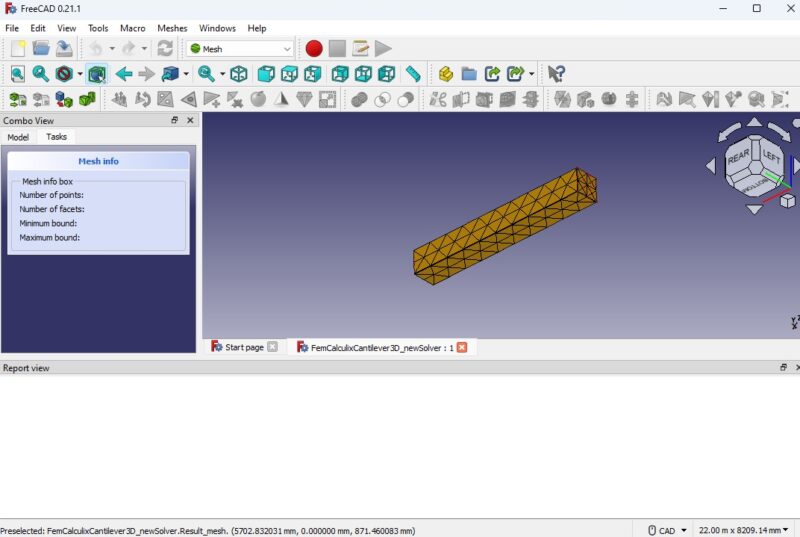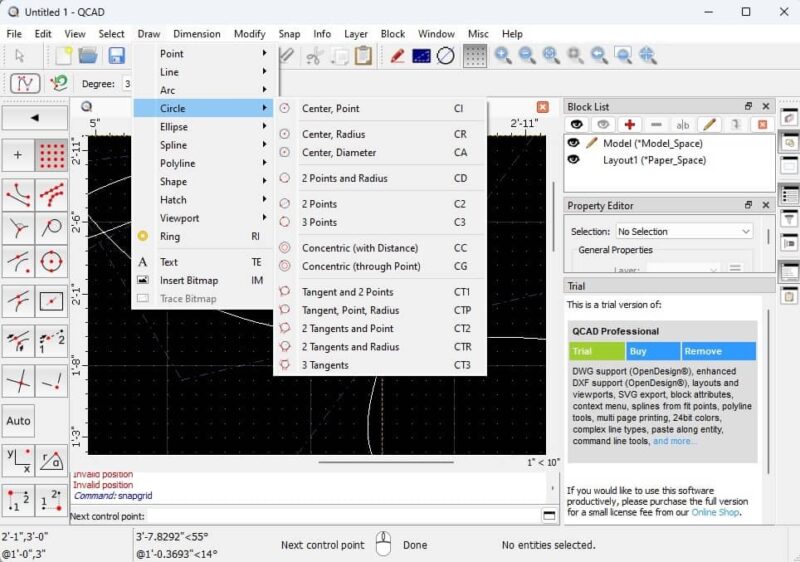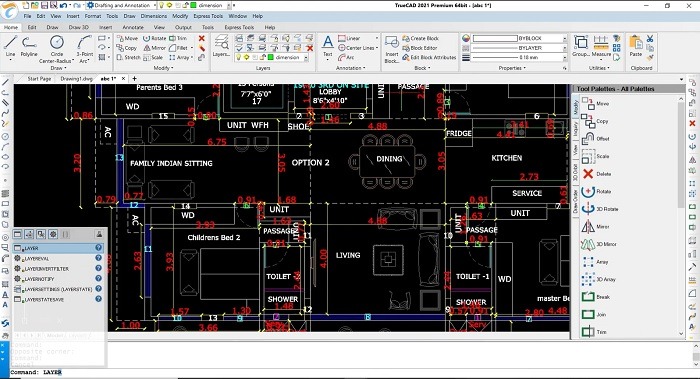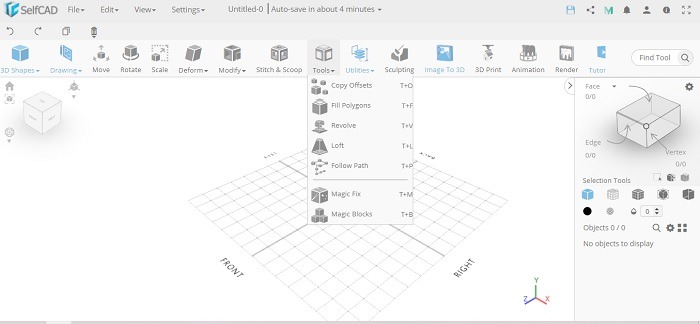
AutoCAD is a flagship product by Autodesk, the drafting industry’s juggernaut, designed to help its users with product or building design, manufacturing planning, construction, and civil infrastructure. It also costs much more than other programs that match its capabilities. Save money with the best alternatives to AutoCAD.
Tip: if you just need to draw diagrams, you don’t need AutoCAD. Check out some of the best online diagramming software.
1. FreeCAD
Price: Free
Platforms: Windows, macOS, Linux
While LibreCAD works great with 2D models, FreeCAD is one of the best open-source alternatives to AutoCAD for 3D modeling, though it supports 2D as well. Plus, it works on most major operating systems.

Parametric modeling is a core feature, allowing you to go back through various changes to build upon them. Dozens of file types are supported, including DWG. Grouped workbenches make it easy to find the tools you need for specific tasks, and more are being added regularly.
The large variety of tools in this free architectural design software can easily rival those in premium alternatives and AutoCAD itself. Plus, it’s free.

Pros
- Free
- Cross-platform
- Support for dozens of file types
- Uses minimal resources to run on older systems
- Active community for support
- Parametric 2D sketcher
- Workbenches make it easier to use
Cons
- Steep learning curve
- Some features may be outdated, depending on community development
2. SolidWorks
Price: Free with premium options
Platforms: Windows, Web
Solidworks is a parametric solid modeler focused mainly around 3D designs, so you’ll need to have some knowledge of engineering terms rather than just geometric ones.

AutoCAD has had pretty good support for 3D modelling, but its greatest strengths remain as a 2D-design and drafting architectural software. This makes Solidworks a solid alternative.
The latest edition of SolidWorks has excellent features, like the ability to do freehand sketches on touchscreens. Despite being primarily focused around 3D modelling, its 2D sketching tool still remains functional, even though it’s much lighter than what you find in AutoCAD.

Pros
- Excellent 3D modeling functionality
- Unbeatable in the fields of engineering and automation
- Compatible with DXF files
- Assesses weak points in designs
- Good 3D-printing compatibility
- Touchscreen-based sketching
- Some command-line functionality
Cons
- Windows only
- Limited 2D sketching
- Expensive
3. BricsCAD
Price: Starts at $314/year or $708/lifetime
Platforms: Windows, macOS, Linux, Web
If you’re familiar with AutoCAD’s 2008 version, BricsCAD has a somewhat similar interface, plus rich features in 2D design and 3D direct modeling. You can use it with most major operating systems and hundreds of third-party apps from across the world that are based on .dwg.

Despite being a paid software like AutoCAD, BricsCAD is more affordable with four editions: Lite, Pro, BIM, and Mechanical. The latter two are feature-packed with tools that aren’t found in AutoCAD, such as Sheet Metal, 3D Compare, and BIM. It also integrates with the cloud, has a robust rendering engine, recognizes XREFS, and is customizable.
If you just need a basic 3D modeling solution, BricsCAD Shape is free. While it doesn’t have the same powerful features, it’s still an impressive offering for free architectural design software.

Pros
- Easy to use if you’re familiar with AutoCAD
- Faster LISP execution
- Perpetual licenses available
- Broad customization and development capability
- Built-in tools, such as IFC import/export, architectural direct modeler with BIM database and SketchUp SKP
- Opens complex drawings faster
- You can read, edit, and save AutoCAD files to .dwg
- Can use AutoCAD customization
- AI-enhanced predictive QUAD cursor works faster on large drawings
Cons
- Has a difficult document management tool
- Limited scope
4. DraftSight
Price: Starts at $249/year
Platforms: Windows, macOS
Draftsight is a professional-grade alternative to AutoCAD, designed for users looking for better ways to read, write, and share .dwg files.

It’s one of the best alternatives to AutoCAD for beginners. Plus, it’s based on advanced architecture with all the tools you need to create technical 2D drawings. The clear interface helps you make accurate revisions, as design elements are stored in layers. You can also create G-Code directly in the program and save and open DXF and DWG files. It has a huge design library, allowing you to use existing designs, do batch-printing, and access macro recording.
However, it only comes in a paid version, but even the cheapest of its pricing plans is good for students or hobbyists. For businesses, DraftSight offers three plans: Professional, Premium, and Network. As you scale up, the tool begins to compete with AutoCAD, offering advanced capabilities if you’re willing to fork over more for these features.

Pros
- Many features
- Good for 2D modeling
- Easy to run with storage space
- Easy to learn and use
- Perpetual license available
- Save and open DWG and DXF files
- Compare designs, add symbols, or append PDFs to project files
Cons
- Doesn’t run LISP routines
- No express tools
- Not useful if you want specialized solutions
5. SketchUp
Price: Free with premium options
Platforms: Web, Windows, macOS, iOS, and Android (Free version is Web only)
Formerly Google SketchUp, this free tool is an excellent pick for CAD professionals. SketchUp is a 3D-modeling program used for a wide range of uses, including interior design; architectural, civil, and mechanical engineering; and video game and film design.

Available as a freeware version, the tool works with several types of files, including DWG, DXF, OBJ, XSI, and more, and can export HD animations and PDFs. While the architecture design software is mainly known for its free version, there are three premium plans available if you need more functionality, such as unlimited access to pre-built 3D models, unlimited cloud storage, and a desktop edition.
It’s also one of the few tools that offers mobile modeling. View models on Android and even create models on iOS devices. The free version doesn’t offer iOS compatibility.

Pros
- Easy to learn and use
- Easy to import different types of files
- Vast library to upload or download drawings
- Good for creating 3D models
- Integrates with third-party plugins
Cons
- Less detailed designs owing to lesser rendering ability
- Doesn’t let you create NURBS
- SketchUp Studio is only for Windows
6. LibreCAD
Price: Free
Platforms: Windows, macOS, Linux
LibreCAD is a high-quality open-source 2D-modeling software birthed from QCAD (later known as CADuntu) and resembles AutoCAD in concept and features. It’s one of the most popular open-source alternatives to AutoCAD.

If you’re familiar with AutoCAD, using LibreCAD is easier, especially for Linux users and those who want a free CAD tool that reads DWG files too. It can also be used with Windows and macOS platforms and is based on Qt, a leading cross-platform application and UI-development framework.
It’s limited to 2D modeling. However, the large community of users is there to help you whenever you need it.

Pros
- Easy to learn and use
- Reads DWG files and other types
- Writes DXF files
- Source code is available on GitHub
- Seamless transition from AutoCAD
- Clutter-free interface
- Not resource-intensive
- Multilingual (more than 30 languages)
- Cross-platform support for Mac, Windows, and Linux OS
- Can export JPG, SVG, PDF, PNG, and other file types
Cons
- 2D only
- No Web version
7. QCAD
Price: Free with premium option
Platforms: Windows, macOS, Linux
If you prefer a more advanced version of LibreCAD, check out QCAD. It’s one of the best AutoCAD alternatives for 2D models and is regularly updated.

It’s open source and cross-platform. If you’re new to CAD tools, it’s a good beginner-friendly option but has ample features for more experienced users. The free version offers more than 40 construction tools and over 20 modification tools.
While the basic version is free, a Professional edition is available with a healthy dose of extra features, such as support for more file formats. However, it’s fairly inexpensive, especially compared to other premium offerings on this list.

Pros
- Built-in part library with over 4,800 CAD parts
- Basic version free
- Import and export DXF and DWG files
- Support for SVG, PDF, JPG, BMP, PNG, XPM, XBM, ICO, TIFF, and more
- Detailed documentation and active community
Cons
- Some file formats are Professional edition only
- 2D only
8. OpenSCAD
Price: Free
Platforms: Windows, macOS, Linux
OpenSCAD is one of the more unique free AutoCAD alternatives that focuses on 3D modeling for machinery and parts. It’s designed for desktop use and doesn’t have a Web version.

It works a little differently than most of the alternatives to AutoCAD on this list. It’s not an interactive 3D modeler. Instead, it works more like a compiler. You’ll use the code editor to make adjustments to colors, sizes, shapes, and positions. Instead of drawing things out yourself, you import libraries (which are free) to build your creation.
Of course, you can also import DXF, STL, and OFF files from AutoCAD and other alternatives on this list. If you’re trying to create detailed 3D models for printing, this is a surprisingly advanced tool once you get used to it. There are ample tutorials on the website to help you get started.
You may want to use a mind-mapping tool like the ones on this list to plan out your design before diving into the tool.

Pros
- Numerous libraries and free resources available on the website
- Has an active Thingiverse community
- Supports DXF, STL, and OFF files
Cons
- Isn’t a true design tool
- Has a learning curve
9. JTS IntelliCAD
Price: $149
Platforms: Windows
When you need professional features at a fraction of the cost of AutoCAD, look no further than JTS IntelliCAD. Formerly known as TrueCAD, this premium tool supports all DWG and DXF versions from R2.2 and later.

Most of the file formats you would want are supported, such as JPG, STL, BMP, TIFF, and more. Easily import and export PDF. There are numerous 2D design tools, along with 3D modeling features. You can even use LISP programs within IntelliCAD or create your own.
While the software isn’t free, it’s surprisingly affordable with a one-time fee. Upgrade to newer versions later on for just $80. The good news is there is a free trial to learn how everything works.

Pros
- Offers many of the same features as AutoCAD
- Supports many file formats
- Works for both 2D and 3D modeling
- Great support for DWG and DXF file versions
- No subscription or upgrades required
Cons
- Only available for Windows Vista and later
10. CMS IntelliCAD
Price: Subscription starts at $130, Stand-alone Perpetual license starts at $280
Platforms: Windows
CMS IntelliCAD is powered by IntelliCAD, just like JTS IntelliCAD. It’s often considered one of the best alternatives to AutoCAD, due to the features and file support.

CMS features DWG and DGN support, PDF import/export, and 2D and 3D modeling. Control your design using a command line, toolbars, and even a ribbon UI. An advanced visual styles and materials library makes it easier to get started on projects. There’s even full LISP compatibility and BIM support.
While it may seem overwhelming to beginners, this is a tool experienced AutoCAD users could fall in love with. A free trial is available.

Pros
- Close AutoCAD competitor
- Advanced design and editing tools
- LISP support
- Native DWG and DGN support
Cons
- Only compatible with Windows
11. Tinkercad
Price: Free
Platforms: Web
Tinkercad is a free educational tool from Autodesk. While it’s not as feature-rich as AutoCAD, it’s an ideal alternative for beginners, hobbyists, and personal drafting projects. While it’s made for students and educators, you can create a personal account for free to start tinkering with new designs.

For anyone just starting out, it’s easily one of the best alternatives to AutoCAD. What sets it apart is the training and tutorials available. You don’t need to be a design and modeling expert to use it. As the name implies, just start tinkering and see what happens.
The platform features 3D modeling, circuit diagrams, and 3D models made from code blocks. If you’re just learning to code, try these coding games. I’d suggest diving into the free lessons, playing around a little, and starting to explore the challenges to really get the hang of things.

Pros
- Numerous tutorials, free samples, and challenges
- Clean interface with intuitive tools
- Multiple ways to create 3D models
- Offers a coding option for design
Cons:
- May be too simple for some users
- Web only
Honorable Mentions
While the above are some of the best drafting software alternatives to AutoCAD, they’re not the only options that deserve a mention.

Some others you may want to check out that aren’t quite as feature rich but still great for personal use and smaller projects include:
- nanoCAD – Offers a free basic option for educational and personal projects only. Five premium plans are available, starting at $180/year. It provides all the tools you need for most drafting projects and is compatible with DWG files. For commercial use and additional features, you’ll need to upgrade to a premium plan.
- SelfCAD – It’s easy enough for beginners to pick up quickly but advanced enough for professional designers to use. It’s perfect for both 2D and 3D models and has both a Web and desktop version (macOS/Windows). The basic version is completely free, but premium plans are available too.
While the best alternatives to AutoCAD might not be identical to AutoCAD, they’re cheaper and may work just as well for what you need. If you’d like to sketch out designs first, versus using just shapes and lines, try these sketching apps. While most AutoCAD alternatives are for desktops, try these online CAD tools for modeling anywhere.
Image credit: Unsplash. All screenshots by Crystal Crowder.
Our latest tutorials delivered straight to your inbox